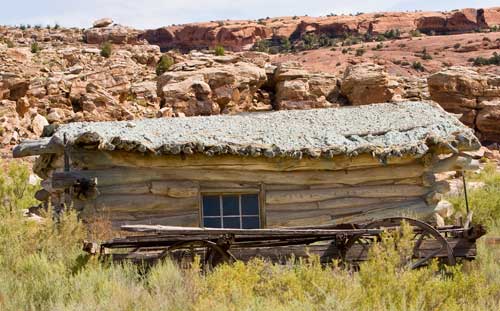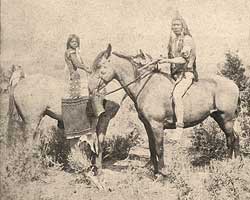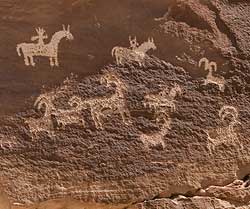 |
| Wolfe Ranch |
Prehistory
Rocks have attracted visitors to Arches National Park for thousands of years. However, sightseeing has not been the main activity for very long. Hunter-gatherers migrated into the area about 10,000 years ago at the end of the Ice Age. As they explored Courthouse Wash and other areas in what is now Arches, they found pockets of chert and chalcedony, microcrystalline quartz perfect for making stone tools. Chipping or knapping these rocks into dart points, knives, and scrapers, they created debris piles that are still visible to the trained eye.
 |
| A Ute warrior and his bride, 1873. Utah owes its name to the Ute Indians who moved into this area around A.D. 1300. |
While no dwellings have been found in Arches, the northern edge of ancestral Puebloan territory, there are rock inscription panels. Like earlier people, the ancestral Puebloans left lithic scatters, often overlooking waterholes where someone may have shaped tools while watching for game. People living in modern-day pueblos like Acoma, Cochiti, Santa Clara, Taos, and the Hopi Mesas are descendants of the ancestral Puebloans.
 |
| The stylized horse and rider surrounded by bighorn sheep and dog-like animals is typical of Ute rock art. |
As the ancestral Puebloan and Fremont peoples were leaving, nomadic Shoshonean peoples such as the Ute and Paiute entered the area and were here to meet the first Europeans in 1776. The petroglyph panel near Wolfe Ranch is believed to have some Ute images since it shows people on horseback, and horses were adopted by the Utes only after they were introduced by the Spanish.
European History
The first Europeans to explore the Southwest were Spaniards. As Spain’s New World empire expanded, they searched for travel routes across the deserts to their California missions. In fact, the Old Spanish Trail linking Santa Fe and Los Angeles ran along the same route, past the park visitor center, that the highway does today.
The first reliable date within Arches is an interesting one. Denis Julien, a French-American trapper with a habit of chiseling his name and the date onto rocks throughout the Southwest, left an inscription in this area: Denis Julien, June 9, 1844. If we only knew what he thought of the wonders he saw!
The first European settlement of Southern Utah arose from the colonizing efforts of the Mormon Church. The Mormons attempted to establish the Elk Mountain Mission in what is now Moab in June of 1855, but conflicts with the Utes caused them to abandon the effort. In the 1880s and 1890s, Moab was settled permanently by ranchers, prospectors, and farmers. One settler even found a beautiful spot within what is now Arches National Park. John Wesley Wolfe, a veteran of the Civil War, built the homestead known as Wolfe Ranch around 1898, seeking good fortune in the newly established State of Utah. It is located on Salt Wash, at the beginning of the Delicate Arch Trail. Wolfe and his family lived there a decade or more, then moved back to Ohio. The cabin remains, an echo of what must have been a remarkable experience.
One of the earliest settlers to describe the beauty of the red rock country around Arches was Loren "Bish" Taylor, who took over the Moab newspaper in 1911 when he was eighteen years old. Bish editorialized for years about the marvels of Moab, and loved exploring and describing the rock wonderland just north of the frontier town. Some of his journeys were with John "Doc" Williams, Moab’s first doctor. As Doc rode his horse north to ranches and other settlements, he often climbed out of Salt Valley to the spot now called Doc Williams Point, stopped to let his horse rest and looked back over the fabulously colored rock fins.
Word spread. Alexander Ringhoffer, a prospector, wrote the Rio Grande Western Railroad in 1923 in an effort to publicize the area and gain support for creating a national park. Ringhoffer led railroad executives interested in attracting more rail passengers into the formations; they were impressed, and the campaign began. The government sent research teams to investigate and gather evidence. On April 12, 1929 President Herbert Hoover signed the legislation creating Arches National Monument, to protect the arches, spires, balanced rocks, and other sandstone formations. On November 12, 1971 congress changed the status of Arches to a National Park, recognizing over 10,000 years of cultural history that flourished in this now famous landscape of sandstone arches and canyons.